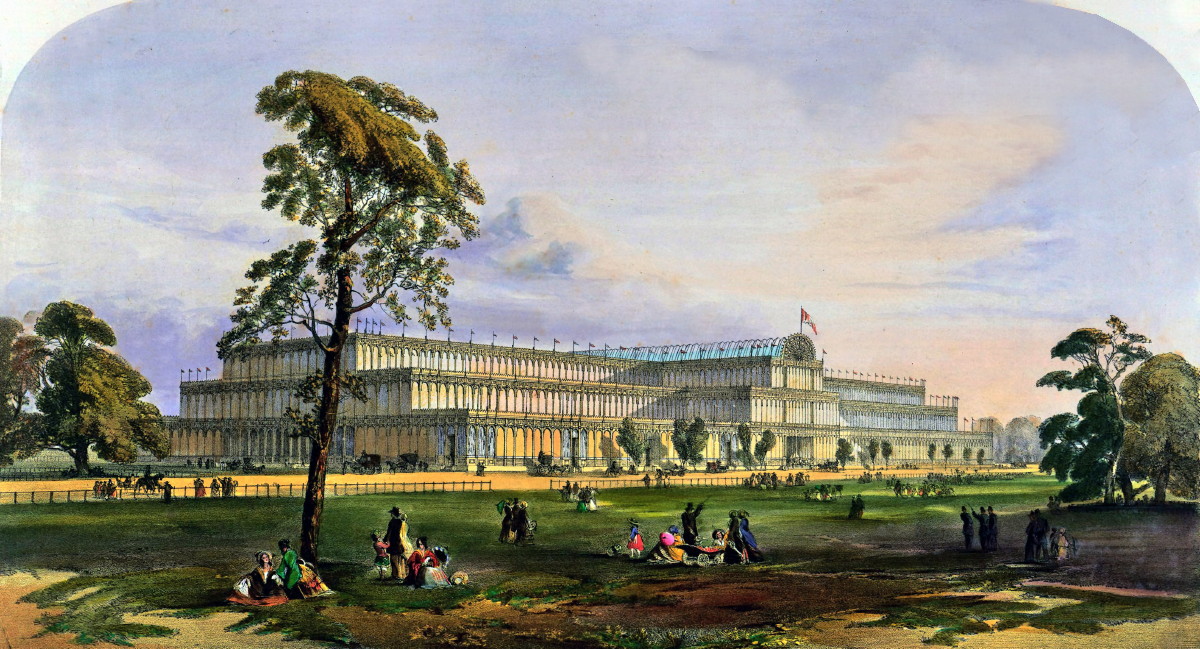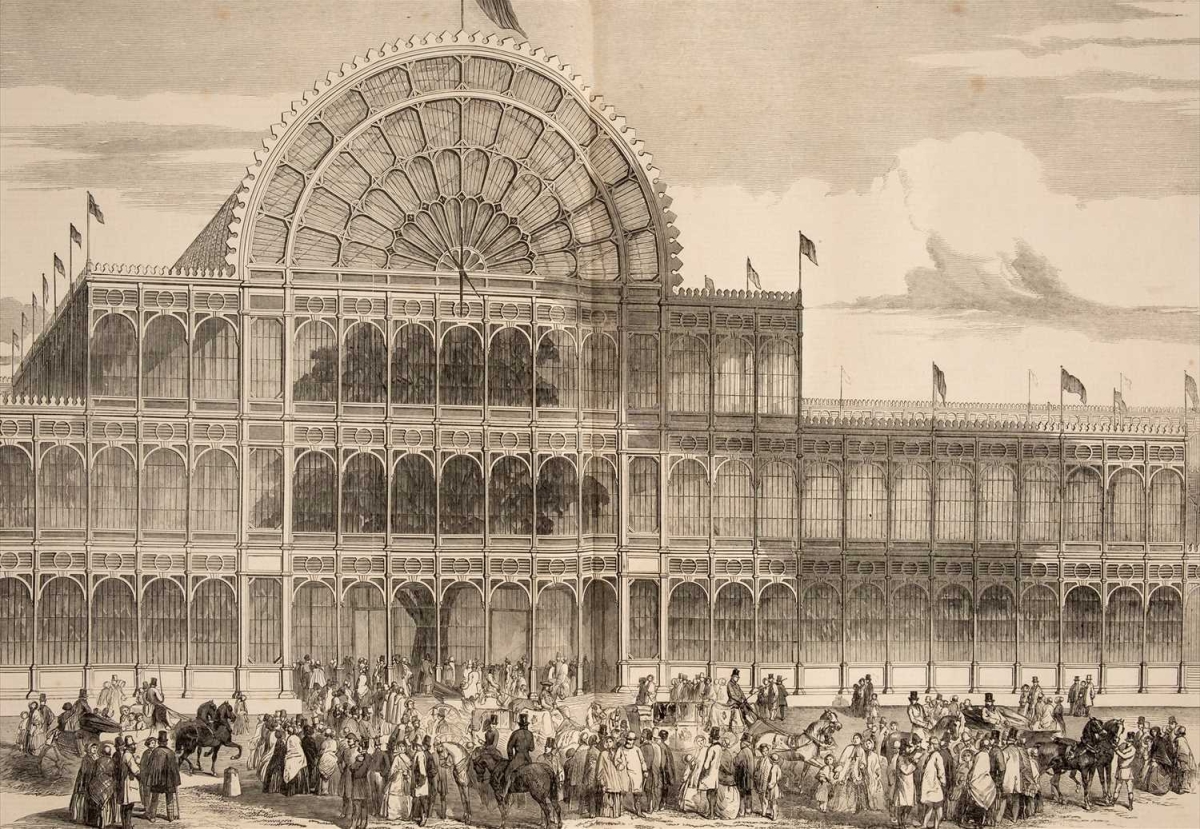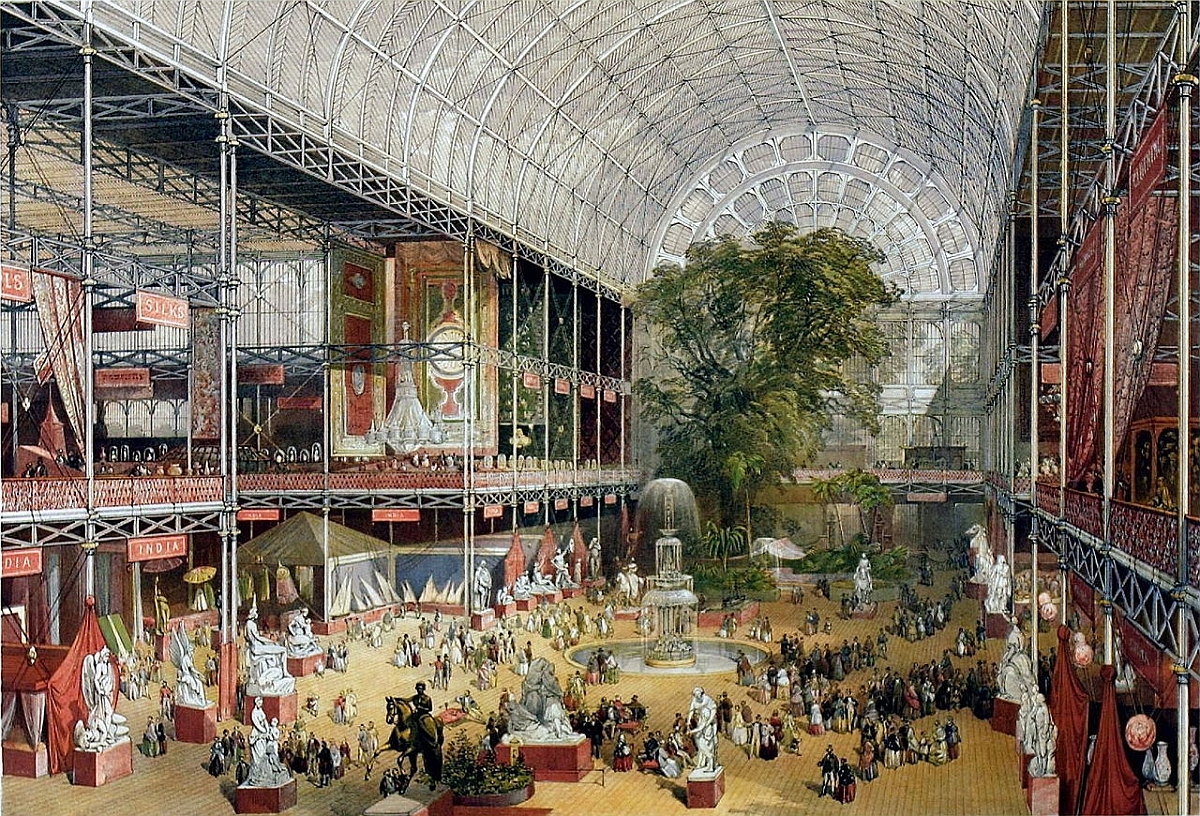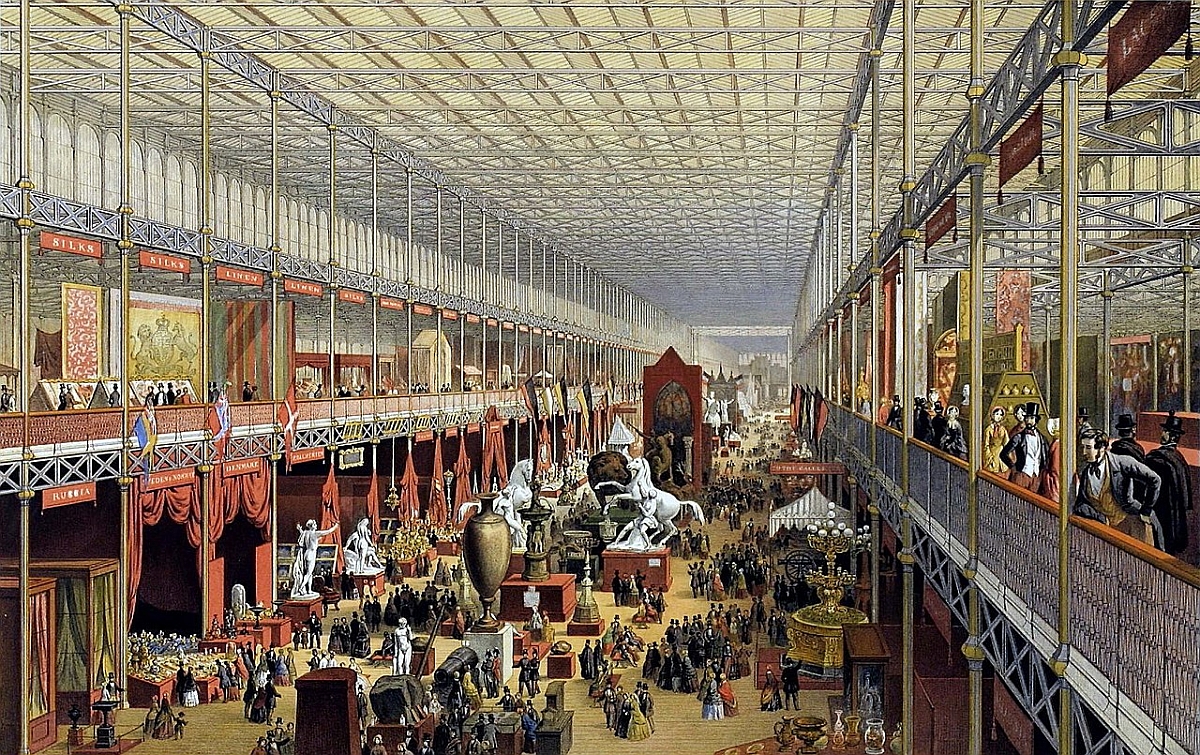|
The Exhibition was closed by Prince Albert in a ceremony on the 15th
October 1851, some 4,500,000 visitors having by then paid a shilling
to enter the Exhibition. The question of what to do with these huge
temporary buildings had then to be addressed. Eventually the
Crystal Palace was bought by a consortium of businessmen who had it
re-erected near Sydenham Hill, south of London, where it housed
concerts, festivals, exhibitions, and permanent displays of botany
and art history until it was completely destroyed by fire in 1936.
――――♦――――
DANGEROUS MONSTER TRAINS
Some trains that conveyed parties of “excursionists” to places and
events were
extremely long. For instance,
an excursion train from
Sheffield to Leeds in September 1840 was pulled by five
locomotives and formed from seventy carriages. Although
split into a number of segments, an excursion from Leeds to Hull
in September 1844 carried a total of 6,600 passengers accommodated in
240 carriages and hauled by nine locomotives:
“CHEAP TRIP TO HULL AND BRIDLINGTON.―This, the
cheapest and the largest of the cheap trips, took place on Thursday
last. The train at Leeds, was divided into four divisions,
drawn by nine engines, containing in the whole 240 carriages, and
conveying 6,600 passengers. It was joined, we understand,
also, by a cheap train from York, bound to the some place, which
added another engine to the number and 1,700 more passengers.
The first division of the from Leeds left the station at six o'clock
in the morning, arriving at Hull at nine a.m., and returned from
Hull at seven, and arrived in Leeds again at ten p.m. The
other divisions of the were much later, the last one not leaving the
station at Leeds till about eight o'clock in the morning, and not
returning to Leeds till after two the next morning.
We understand that on account of numerous applications for a second
trip, the directors will arrange for one in the week following
Doncaster races, which we hope will be on the Monday, as it will be
a convenient day for a great number of persons. We believe
also that a trip to London is in contemplation. On the same day as
the trip to Hull from this town, there was a special train from
Derby to York, with 42 carriages, conveying 1,400 passengers.
We are glad to hear that, large as the trains were, no accident
occurred.”
Leeds Times,
14th September 1844
The Board of Trade became concerned and issued a warning about the
dangers inherent in working what they described as “monster” trains:
“EXCURSION TRAINS ON RAILWAYS.―The Boyd of
Trade has just issued a circular to the several railway companies,
calling their attention to the danger of the plan adopted by some
railways of running excursion trains drawn by several engines.
They state that the opinion of several of the most experienced
practical men has been taken, and that they all state the present
mode of working the excursion trains to be extremely dangerous; and
the Board of Trade recommend that these excursion trains should be
divided into sections, so that no more than two engines should be
used with any one train of carriages.
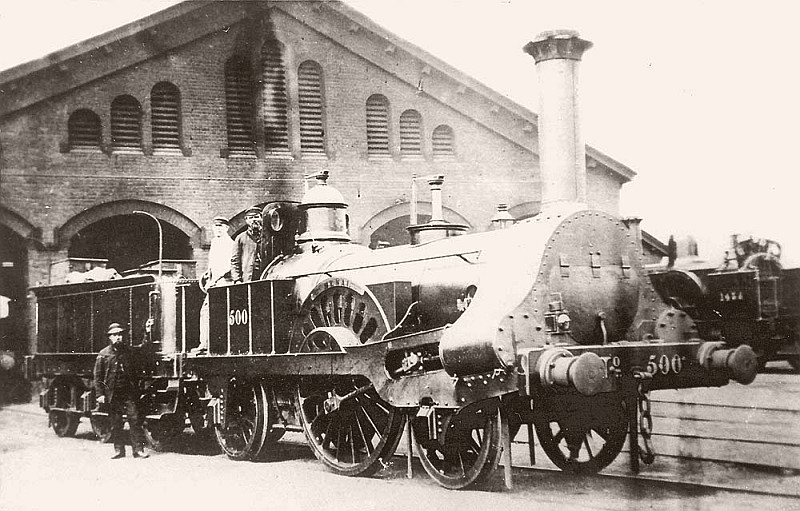
A Francis Trevithick L&NWR passenger
locomotive of the period
They also point out the extreme danger likely to arise from the want
of punctuality in the arrival of these excursion trains arising from
their great weight;
[2]
and they strongly urge upon the companies to
adopt a different mode of working the excursion trains in order to
avoid the danger of the present method. It ought to he
observed that very few companies have adopted these ‘monster trains,’
and it is to be observed that those which have adopted them will
alter their arrangements to such as are more compatible with
safety.”
Ipswich
Journal, 26th October 1844
――――♦――――
THE AYLESBURY EXCURSION
On Monday
the 21st July, 1851, an excursion train left Aylesbury for
Euston, stopping to pick up additional excursionists at Tring.
How was that accomplished?
When the London & Birmingham Railway was in course of construction,
a group of Aylesbury business people formed the Aylesbury Railway
Company to build a branch line from the town to Cheddington where it
formed a junction with the main line. The Cheddington branch,
which
opened on the 10th June 1839, was absorbed into the newly formed
London & North Western Railway in 1846. After more direct
railway routes were opened, the Cheddington branch ceased to be a useful
route from Aylesbury to London, and during the 20th century the
line began to lose business. Eventually it closed to passengers in
1953 and to freight ten years later, after which the line was taken up.
Returning to the excursion, when the train from Aylesbury reached Cheddington
it needed to head south, but as the junction with the main
line was in the down direction, to accomplish this about-face either the
locomotives needed to be moved to the opposite end of the excursion
train or the excursionists had to cross the main line to board a southbound train.
The following article fails to mention how this manoeuvre was
achieved.
――――♦――――
A DAY OUT IN TOWN . . .
.
. . . . from the Bucks
Herald, 26th July, 1851.
“On Monday the excursion train took up a
goodly number of passengers from this town and adjoining villages.
The train when it started from the Aylesbury station consisted of 32
carriages, drawn by two engines, and contained 951 passengers.
On
arriving at Tring it was found impossible to accommodate the
numerous holiday folk who had assembled there to proceed by the
train to London, and it was found necessary to forward by far the
greater portion of them by an additional train, no less a number
than 676 persons taking advantage of the opportunity afforded by the
Company of visiting the Great Exhibition.
The train arrived at the Euston station about half-past eight in the
morning, thus affording those who wish to return the same night
nearly twelve hours for their visit to the metropolis; but a large
number availed themselves of the option so liberally granted by the
Company and remained till the Wednesday night.
Connected with this truly liberal and cheap trip and we hope to see
others announced, many treats were afforded by masters to their
servants, and amongst the foremost we have much pleasure in
recording an act of kindness on the part of Mr. Fowler of the White
Hart Inn, Aylesbury, and which is worthy of being followed by others
in the neighbourhood. We allude to the fact of the whole of the
agricultural labourers in that gentleman's father's employ, an also
the servants connected with the inn to a number of 24, being
conveyed to London at their master's expense, as likewise their
admittance to the Crystal Palace. Previous to starting, however,
they all assembled at Mr. Fowler's house, and having partaken of a
good substantial breakfast, proceeded at once to the train, dressed
in their white smock-frocks, and headed by Mr. Fowler, jun.
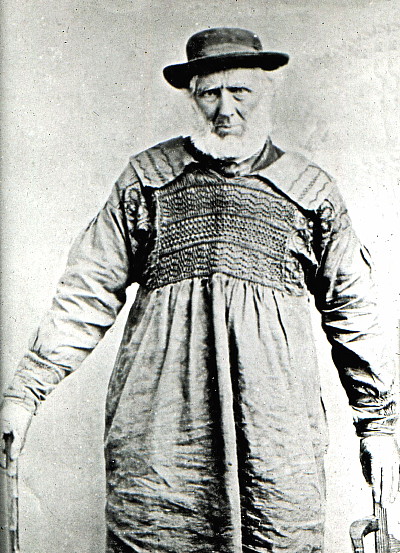
Farm labourer dressed in a smock-frock
On the arrival of the train at the Euston-station, a conveyance
having been specially engaged on the previous Saturday, the whole
party were taken by Mr. Fowler to Westminster Bridge, who pointed
out to them the various sights as they passed along, and after
viewing the river and the wonders of the steam boats, they attended
Westminster Hall, and afterwards the Abbey, where we had the
gratification of unexpectedly meeting them, and attended the usual
morning service in that noble and sacred edifice. Whatever might
have been their conception of the choral performances of the
splendid choir of the Abbey, it was curious ever and anon to witness
their eyes directed to the magnificent stained windows therein
contained. After divine service had concluded, the party proceeded
to Hyde Park, and having here refreshed the "inward man," under the
trees, entered the Crystal Palace, the objects of interest being
here also pointed out to them by Mr. Fowler.
About five o'clock they left the building, and after partaking of a
cold collation under the trees near the Serpentine, they proceeded
homewards to Euston-square, highly gratified by their visit, and on
their return to Aylesbury, found a supper provided for them by Mr.
Fowler, sen., and having done justice thereto, started off to their
respective homes. We are glad to find that this example was not
confined to Mr. Fowler alone. We had much pleasure in observing the
labourers of Mr. Farmbrough, of Broughton, who were kindly escorted
by that worthy individual and his friends, and no exertion seemed to
be wanting on their part to render every substance and impart to
their men all the information they required. They were taken direct
from Euston-square to the Exhibition, and having met at two o'clock
at the centre fountain, walked to Westminster Abbey and the New
Houses of Parliament; then, getting on a steam-boat they were taken
to London Bridge, and having embarked, they saw, in addition to the
shipping on the Thames, the Monument, Bank, Royal Exchange, St.
Paul's, and numerous other noble structures; thus seeing as much of
London and the Exhibition as was possible in one day. We need
scarcely say that they returned home highly delighted, having seen
so much without spending any of their hard-earned wages.
We must not omit mentioning also at similar treat being afforded by
Mr. E. Butchers, farmer, of Hadenham, to the labourers in his
employ.
These are, undoubtedly, examples well worthy of imitation, as it
would be next to useless to treat these men to London and the
Exhibition and then leave them -- for they would return home almost
as ignorant as when they started; but having a conductor it enables
them to see a vast deal, and impresses itself on the mind in a
manner not easily to be forgotten.
We cannot close this account without noticing the very excellent
arrangements that were made by the station master, Mr. Judd, who, by
his early attendance in the morning, greatly facilitated the good
order and regularity which prevailed upon the starting of the train.
The guards and servants likewise connected with the company seemed
to co-operate in rendering every accommodation in their power to to
afford comfort to the excursionists. ‘We are happy to inform our
readers that not the slightest accident occurred to mar the
pleasures of an event so truly interesting.”
――――♦―――― |

